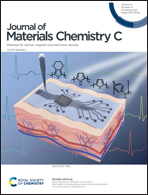Performance enhancement of a p-Si/n-ZnGa2O4 heterojunction solar-blind UV photodetector through interface engineering†
Abstract
Interface engineering is an effective way to improve the performance of heterojunction photodetectors (PDs). We have constructed p-Si/n-ZnGa2O4 heterojunction solar-blind ultraviolet (UV) PDs with and without an SiO2 interfacial layer and studied the effect of the SiO2 interfacial layer on device performance in detail. At −1 V bias, the dark current of the device from 3.8 × 10−8 A to 5.7 × 10−12 A was greatly reduced, specifically 6.7 × 103 fold, attributed to the high barrier induced by the insertion of the SiO2 interfacial layer. With the introduction of the SiO2 interfacial layer, the photo-to-dark current ratio and the detectivity of the device were greatly improved due to the substantial reduction of dark current. Owing to the insertion of the SiO2 layer reducing the carrier trapping at the interface defects, the rise and decay times of the device were significantly reduced from 0.96 s/0.88 s to 0.12 s/0.08 s, i.e. 8 fold and 11 fold, respectively. Moreover, the large conduction band offset of Si/SiO2 could effectively block visible-light-generated electrons in Si, thereby suppressing the visible-light response and enhancing the UV-visible rejection ratio of the Si/SiO2/ZnGa2O4 PD. Our work has provided a feasible approach for enhancing the performance of Si/wide-bandgap semiconductor heterojunction solar-blind UV PDs.



 Please wait while we load your content...
Please wait while we load your content...